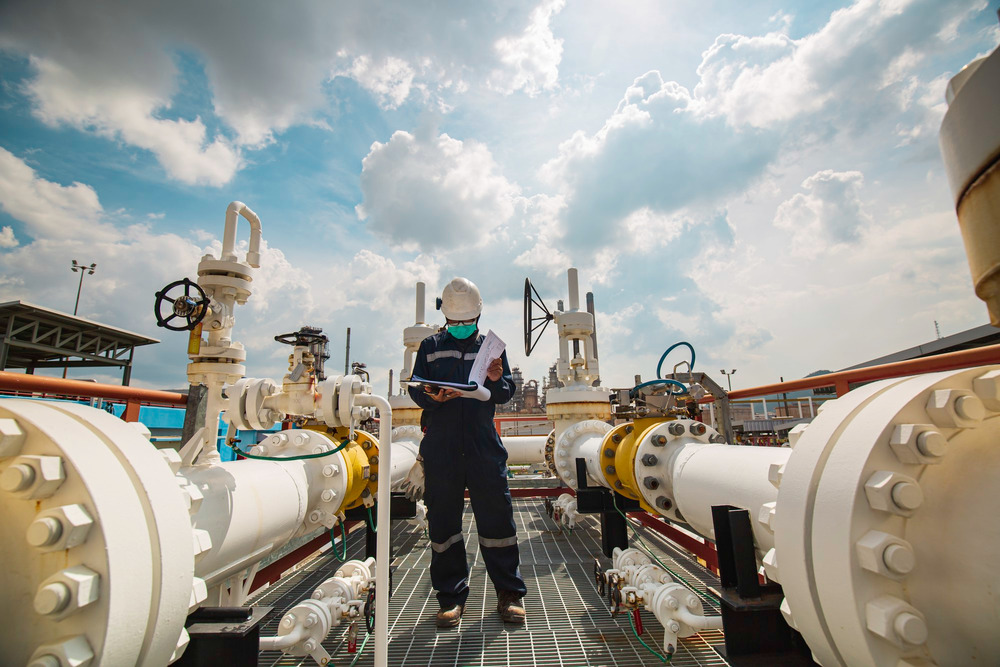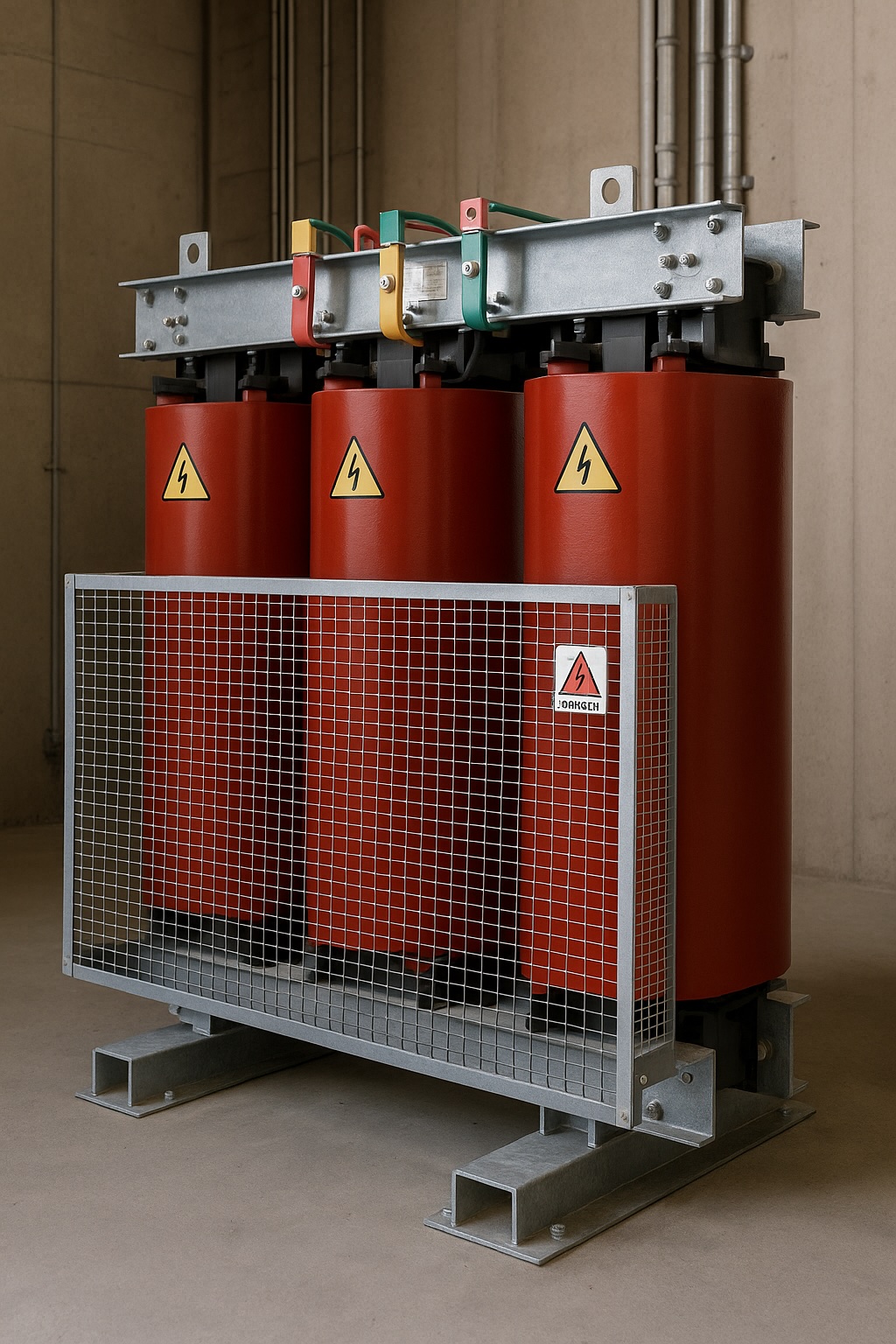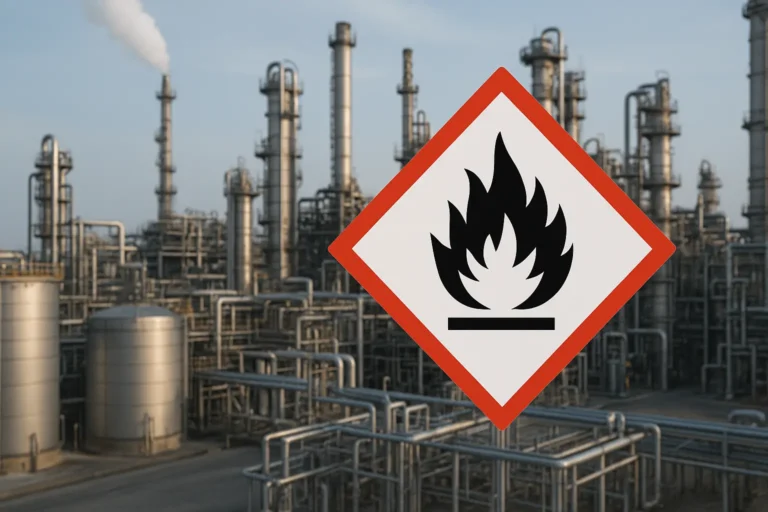What is Industry 4.0? What are Industry 4.0 Innovations?
In the era of rapid technological advancement, Industry 4.0 represents the next stage of industrial transformation, integrating smart technologies, automation,...
Devamını Oku

A dry-type transformer is a type of electrical transformer that operates without the use of liquid insulation, making it a safer and more environmentally friendly option in modern power systems. Instead of oil, these transformers use solid insulation, typically epoxy resin, to isolate the windings. This design significantly reduces the risk of fire, making them ideal for use in indoor and high-risk environments such as hospitals, commercial buildings, and data centers.
Referred to simply as a dry transformer, this equipment is widely used in energy distribution systems due to its enhanced safety, reduced maintenance, and resistance to harsh environmental conditions. Its compact structure and quiet operation make it well-suited for confined installations where space and noise control are critical. In this guide, we’ll cover in detail what is a dry-type transformer, its key features, applications, dimensions, and how tap settings are adjusted.
In addition, this content will explain what goes into dry-type transformer specifications and what factors should be considered when selecting the most suitable transformer for a specific application. Supported by Adatech’s expertise in engineering, design, and installation, this article provides a comprehensive resource for professionals seeking reliable, efficient, and sustainable energy solutions.
A dry-type transformer is an electrical device used to convert voltage levels without the use of any insulating liquids. Instead, its windings and core are cooled by natural air circulation or fan-assisted systems. Solid insulation materials such as epoxy resin are used to encapsulate the windings, which makes the transformer highly resistant to moisture, contaminants, and fire hazards. This design ensures both operational safety and environmental sustainability, especially in enclosed or sensitive areas.
These transformers are typically used in low and medium voltage applications. Because they do not contain oil, they are ideal for locations where fire safety is critical. Understanding what is a dry-type transformer means recognizing its practical advantages—reliable performance, low maintenance, and compliance with environmental and safety standards. From commercial buildings to industrial plants, dry-type transformers offer a clean, efficient, and space-saving alternative for modern energy distribution needs.
A dry-type transformer is preferred in environments where fire safety, minimal maintenance, and environmental compatibility are essential. These include indoor installations such as hospitals, office complexes, schools, shopping malls, and high-rise buildings, where the absence of oil significantly reduces the risk of fire and hazardous leaks. Their silent operation and compact design also make them suitable for densely populated or noise-sensitive areas.
In industrial settings, dry-type transformers are ideal for harsh conditions—such as humid, dusty, or chemically exposed areas—where traditional oil-filled units would pose risks or require frequent upkeep. Thanks to their robust insulation and strong thermal resistance, dry-type transformers ensure operational continuity and safety even under challenging conditions. Their flexibility and safety features make them a top choice across diverse applications.
A dry-type transformer is primarily used to convert voltage levels within electrical systems, ensuring that electricity is safely and efficiently distributed from one point to another. It steps up or steps down voltage levels to match the requirements of connected equipment or infrastructure. This function is critical in both commercial and industrial power distribution, allowing systems to operate within safe voltage parameters while minimizing energy losses.
Beyond voltage transformation, dry-type transformers also serve other essential roles, such as providing electrical isolation, improving system reliability, and enhancing protection against short circuits or overloads. Their durable design and solid insulation make them suitable for continuous operation in environments where safety and sustainability are priorities. Understanding what is a dry-type transformer used for is key to selecting the right model for reliable and efficient energy management.
Dry-type transformer features distinguish these devices as safe, efficient, and environmentally responsible solutions for voltage conversion. One of their most notable characteristics is the absence of insulating oil—epoxy resin or cast coil insulation is used instead. This significantly reduces fire risk and eliminates the potential for fluid leaks, making these transformers suitable for indoor and environmentally sensitive locations. They also operate with minimal noise, which is advantageous in hospitals, offices, and residential buildings.
These transformers are highly resistant to moisture and dust, allowing them to function reliably even in harsh or humid environments. Their compact structure makes installation easier in space-limited areas. Additionally, dry-type transformers offer excellent overload performance, require low maintenance, and have a long service life. Other notable features include strong dielectric strength, thermal stability, and compliance with international safety standards. As such, dry-type transformers are ideal for energy-efficient and sustainable infrastructure projects.
Understanding how to adjust the tap settings of a dry-type transformer is essential for regulating voltage levels in varying power conditions. Tap settings are adjustments made on the primary winding of the transformer to compensate for voltage fluctuations. These taps are usually built into the winding terminals and allow voltage to be fine-tuned, typically in steps of ±2.5% or ±5%. Adjustments are made manually and only when the transformer is de-energized to ensure safety.
To perform the adjustment, a technician changes the connection point on the winding using the clearly marked tap terminals. It’s crucial to follow the transformer’s schematic and technical manual, as improper connections can lead to imbalance or system faults. These settings are particularly useful in areas with unstable supply voltages or where precise voltage output is required for sensitive equipment. The ability to manually adjust taps enhances the dry-type transformer’s versatility and ensures consistent performance in diverse operating conditions.
Dry-type transformer dimensions vary depending on the power rating, cooling method, and installation environment. These transformers typically range from 100 kVA up to 2500 kVA or more. As the power rating increases, so do the physical dimensions, requiring careful planning during installation. For example, a 250 kVA unit might require less than 1 square meter of space, while a 2000 kVA transformer may occupy several square meters and weigh over a ton. Cooling systems (natural or fan-assisted) and protection enclosures can also impact size.
Besides external dimensions, other key measurements include terminal clearances, cable entry points, and ventilation space requirements. Choosing the right size is not just about physical fit—it must also align with load demands and safety standards. Adatech, for instance, offers tailored transformer designs that consider all spatial, thermal, and operational factors, ensuring that each dry-type transformer meets the specific needs of its installation site efficiently and safely.
Standard dry-type transformer dimensions are designed to suit a variety of applications and installation constraints. For example, a 100 kVA transformer may measure around 900 mm x 700 mm in footprint, while a 1600 kVA unit can exceed 2000 mm x 1500 mm. These measurements include core, windings, and cooling systems, but not the clearance space needed for ventilation or maintenance access. Industry guidelines recommend leaving adequate space—usually 800 mm or more—on all sides to allow for proper airflow and safety.
In addition to dimensions, the installation area must support the transformer’s weight and prevent vibration transfer. Sufficient cooling airflow, easy access for servicing, and proper grounding infrastructure are also essential. Planning the layout with these considerations helps ensure safe and efficient operation. Adatech supports its clients with expert evaluation of site conditions to match the correct transformer size with structural and operational requirements.
Dry-type transformers can be categorized by power rating—small (up to 400 kVA), medium (500–1250 kVA), and large (1600 kVA and above)—each with unique physical and operational traits. Small transformers are compact and lightweight, making them ideal for schools, offices, and small commercial facilities. They are easy to install and typically air-cooled without the need for forced ventilation.
Medium power transformers serve larger buildings and light industrial setups. They require more space, often include enhanced cooling features, and may need sound enclosures. Large power dry transformers are used in energy-intensive environments like factories, hospitals, and data centers. They have more robust construction, advanced thermal management systems, and require careful planning for installation. Selecting the right size ensures efficient energy use and long-term system stability.
Dry-type transformer specifications outline all critical technical and operational requirements necessary for selecting, manufacturing, and installing a transformer. These specifications typically include rated power (kVA), primary and secondary voltages, frequency (usually 50 or 60 Hz), insulation class, cooling type (natural or forced air), and short-circuit withstand capabilities. They also specify the type of insulation (commonly epoxy resin), winding materials (often copper), temperature rise limits, and protection ratings such as IP20 or IP23.
Beyond electrical properties, the specification will also detail physical dimensions, weight, terminal locations, installation clearances, and sound levels. Guidelines for grounding, vibration resistance, maintenance access, and safety certifications are commonly included. Dry-type transformer specifications ensure that each unit performs reliably under expected environmental and load conditions. Companies like Adatech follow international standards and project-specific needs to deliver customized transformer solutions that meet both regulatory and practical demands.
Choosing the right dry transformer involves evaluating more than just voltage and power ratings. The first step is to define the total load and type of application—whether it’s for a commercial facility, industrial plant, or critical infrastructure like hospitals or data centers. Next, assess the voltage levels, system configuration (e.g., delta or wye), and the presence of any harmonics or special load conditions that might require custom features.
Environmental factors are equally important. Humidity, dust, altitude, and temperature affect insulation and cooling performance, so they must be matched with appropriate dry-type transformer features. Space constraints and accessibility for maintenance are also vital. Moreover, checking dry-type transformer specifications such as insulation class, tap changer configuration, and cooling type will ensure long-term reliability. With Adatech’s engineering-driven approach, clients receive expert guidance to select transformers that optimize performance, safety, and energy efficiency for their specific projects.

In the era of rapid technological advancement, Industry 4.0 represents the next stage of industrial transformation, integrating smart technologies, automation,...
Devamını Oku
In industrial safety, minimizing risks is not only about equipment quality but also about understanding the physical and chemical properties...
Devamını Oku
In today’s rapidly evolving technological landscape, smart building automation has become a critical innovation for managing modern infrastructures efficiently. These...
Devamını OkuPROTECTION OF PERSONAL DATA
WEBSITE COOKIE POLICY
Your personal data; It is one of the leading principles of our Organization to protect the privacy of visitors to the website (www.adatech.com.tr) operated by ADATECH as the data controller. This Cookie Usage Policy (“Policy”) explains to all our website visitors and users which types of cookies are used and under what conditions.
Cookies are small text files stored on your device or network server by websites you visit on your computer or mobile device.
They are generally used to provide you with a personalized experience during your use of the website you visit, to improve the services offered and to improve your experience, and may contribute to ease of use while browsing a website. If you do not prefer the use of Cookies, you can delete or block Cookies in your browser settings. However, we would like to remind you that this may affect your use of our website. Unless you change your cookie settings in your browser, we will assume that you accept the use of cookies on this website.
1. WHAT KIND OF DATA IS PROCESSED IN COOKIES?
Cookies on websites, depending on their type, collect data about your browsing and usage preferences on the device you visit the site. This data includes information about the pages you access, the services and products you review, your preferred language option and other preferences.
2. WHAT is a solution and what are its intended uses?
Cookies are small text files that are stored on your device or network server through browsers by websites you visit. These small text files, which contain your preferred language and other settings on the site, help us remember your preferences the next time you visit the site and make improvements to our services to improve your experience on the site. Thus, you can have a better and personalized usage experience on your next visit.
The main purposes of using cookies on our Website are listed below:
3.TYPES OF COOKIES USED ON OUR WEBSITE
3.1. Oturum Çerezleri
Session cookies ensure that the website functions properly during your visit. They are used for purposes such as ensuring the security and continuity of our sites and you during your visit. Session cookies are temporary cookies, they are deleted when you close your browser and come to our site again, they are not permanent.
3.2. Persistent Cookies
These types of cookies are used to remember your preferences and are stored on your device via browsers. Persistent cookies remain stored even after you close your browser or restart your computer from which you visited our site. These cookies are kept in subfolders of your browser until they are deleted through your browser’s settings.
Some types of persistent cookies may be used to provide you with special suggestions, taking into account issues such as your purpose of using the Website.
Thanks to persistent cookies, if you visit our Website again with the same device, it is checked whether there is a cookie created by our Website on your device and if there is, it is understood that you have visited the site before and the content to be transmitted to you is determined accordingly and thus a better service is provided to you.
3.3. Mandatory/Technical Cookies
These cookies are essential for the website you visit to function properly. The purpose of such cookies is to provide necessary services by enabling the website to function. For example, it allows you to access secure parts of the website, to use its features, to navigate on it.
3.4. Analytical Cookies
They collect information about the way the website is used, the frequency and number of visits, and show how visitors navigate to the site. The purpose of using such cookies is to increase performance by improving the way the site functions and to determine the general trend direction. They do not contain data that could enable the identification of visitors. For example, they show the number of error messages displayed or the most visited pages.
3.5. Functional/Functional Cookies
It saves the choices made by the visitor within the site and remembers them on the next visit. The purpose of such cookies is to provide ease of use to visitors. For example, it prevents the site user from re-entering the user password on each page they visit.
3.6. Targeting/Advertising Cookies
They enable the measurement of the effectiveness of advertisements served to visitors and the calculation of the number of times the advertisements are viewed. The purpose of such cookies is to serve ads customized to the interests of visitors.
Likewise, they enable the detection of visitors’ interests specific to their browsing and the presentation of appropriate content. For example, it prevents the advertisement shown to the visitor from being shown again in a short time.
4. HOW TO MANAGE COOKIE PREFERENCES?
To change your preferences regarding the use of cookies or to block or delete cookies, simply change your browser settings.
Many browsers give you the option to accept or reject cookies, accept only certain types of cookies, or be alerted by the browser when a website requests to store cookies on your device so that you can control cookies.
It is also possible to delete cookies previously saved in your browser.
If you disable or refuse cookies, you may need to set some preferences manually, some features and services on the website may not function properly as we will not be able to recognize and associate your account. You can change the settings of your browser by clicking on the relevant link from the table below.
5. ENFORCEMENT OF WEBSITE PRIVACY POLICY
Website Privacy Policy …./…./…./…. . is dated. In case all or certain articles of the Policy are renewed, the effective date of the Policy will be updated. The Privacy Policy is published on the website of the Authority (www.adatech.com.tr) and made available to the relevant persons upon the request of the personal data owners.
ADATECH
Address: Esenyalı Neighborhood Yanyol Street Varyap Plaza No:61-148 Pendik / Istanbul
Telephone: +90 (216 ) 514 80 69
E-mail: [email protected]
Web Address: www.adatech.com.tr